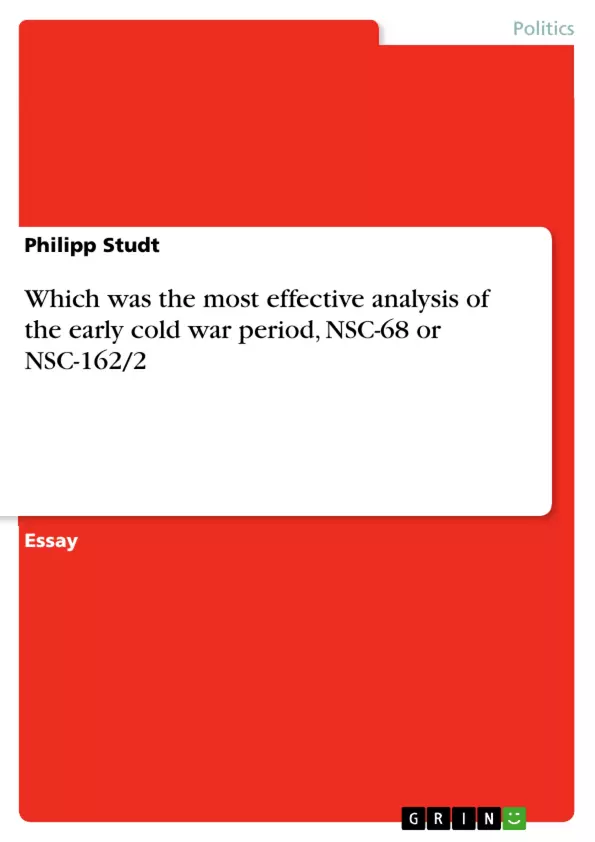In the period after the end of World War II, America struggled to find a sustainable, coherent strategy to address the Soviet threat. It is without doubt that both NSC-68 and NSC-162/2 were important documents of their time. It is the aim of this essay to examine the circumstances of their creation, their differences and ultimately, assess which was a more coherent and effective analysis of the early Cold War Period, placing particular emphasis on the perception of international order in the papers. NSC 68 was produced in 1949 by a study group from the Departments of State and Defense under the leadership of Paul Nietze. Its primary concern were the implications of the Soviet possession of the atomic bomb, the uncovering of the spy ring around Fuchs that had infiltrated the Manhattan Project, the recent creation of the German Democratic Republic and the fall of China to Communism. The paper rested on the premise that the decisive struggle in foreign affairs was between the United States and Soviet Russia, and that there could only be one winner. One of the main arguments put forward was that the totalitarian nature of Soviet Russia allowed nothing but an expansionist foreign policy, “driven to follow this policy because it cannot (…) tolerate the existence of free societies.” According to the paper, the Soviets were motivated by “a new, fanatic faith, antithetical to our own”, seeking to “impose its absolute authority over the rest of the world.” Wolfe makes the point inThe Rise and Fall of the Soviet Threatthat NSC 68 denied that the Russians were capable of acting like other great powers, unable to strike a balance between maximizing their power in some places and minimizing their losses in others, instead expanding everywhere driven by their internal character.3The policy of NSC 68 was, in its own terms, a “policy of calculated and gradual coercion” in order to “check and roll back the Kremlin’s drive
Inhaltsverzeichnis (Table of Contents)
- Introduction
- NSC-68
- Creation and Context
- Key Arguments
- Criticisms
- Operation Solarium
- Group A: Containment
- Group B: Line of Non-Aggression
- Group C: Active Measures
- NSC 162/2
- Assessing the Analyses
Zielsetzung und Themenschwerpunkte (Objectives and Key Themes)
This essay aims to analyze the circumstances surrounding the creation of NSC-68 and NSC-162/2, examine their differences, and ultimately assess which document provided a more coherent and effective analysis of the early Cold War period. The essay focuses particularly on the perception of international order as presented in these papers.
- The Soviet threat in the early Cold War
- The role of ideology in shaping foreign policy
- Competing policy approaches to the Soviet Union
- The evolution of U.S. national security strategy
- The impact of domestic politics on foreign policy decision-making
Zusammenfassung der Kapitel (Chapter Summaries)
- Introduction: This section provides background on the challenges faced by the United States in the aftermath of World War II, outlining the need for a coherent strategy to address the Soviet threat.
- NSC-68: This section examines the origins, key arguments, and criticisms of NSC-68, a document that was instrumental in shaping U.S. foreign policy in the early Cold War. It emphasizes the paper's assumption of an inherently expansionist Soviet Union driven by ideological factors.
- Operation Solarium: This section explores the "Operation Solarium" exercise undertaken by the Eisenhower administration, which involved three task forces developing competing approaches to national security policy. It describes the main recommendations of each group, focusing on the contrasting views of containment, active measures, and a line of non-aggression.
- NSC 162/2: This section discusses the outcome of Operation Solarium, which led to the creation of NSC 162/2. It highlights the influence of each task force on the final policy document, emphasizing the importance of containment and the shift towards nuclear deterrence.
- Assessing the Analyses: This section initiates a discussion on the accuracy and effectiveness of the analyses presented in NSC-68 and NSC 162/2. It explores the extent to which U.S. decision-makers may have misinterpreted Soviet intentions and the role of domestic politics in shaping foreign policy.
Schlüsselwörter (Keywords)
The key terms and concepts examined in this essay include the Cold War, NSC-68, NSC-162/2, containment, Operation Solarium, Soviet expansionism, ideological conflict, U.S. national security strategy, nuclear deterrence, and the role of domestic politics in foreign policy.
- Arbeit zitieren
- Philipp Studt (Autor:in), 2005, Which was the most effective analysis of the early cold war period, NSC-68 or NSC-162/2, München, GRIN Verlag, https://www.grin.com/document/53223



